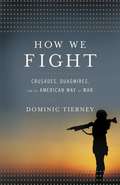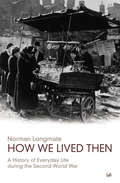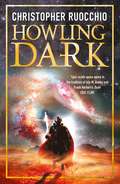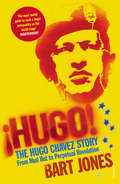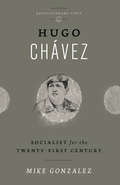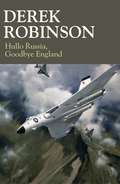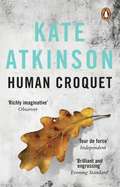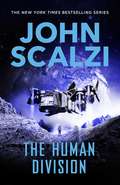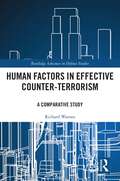- Table View
- List View
How We Fight: Crusades, Quagmires, and the American Way of War
by Dominic TierneyAmericans love war. We've never run from a fight. Our triumphs from the American Revolution to World War II define who we are as a nation and a people. Americans hate war. Our leaders rush us into conflicts without knowing the facts or understanding the consequences. Korea, Vietnam, and now Iraq and Afghanistan define who we are as a nation and a people. How We Fight explores the extraordinary doublemindedness with which Americans approach war, and reveals the opposing mindsets that have governed our responses throughout history: the "crusade" tradition-our grand quests to defend democratic values and overthrow tyrants; and the "quagmire" tradition-our resistance to the work of nation-building and its inevitable cost in dollars and American lives. How can one nation be so split? Studying conflicts from the Civil War to the present, Dominic Tierney has created a secret history of American foreign policy and a frank and insightful look at how Americans respond to the ultimate challenge. And he shows how success is possible. His innovative model for tackling the challenges of modern war can mean longstanding victory in Iraq and Afghanistan, by rediscovering a lost American warrior tradition.
How We Lived Then: History of Everyday Life During the Second World War, A
by Norman LongmateAlthough nearly 90% of the population of Great Britain remained civilians throughout the war, or for a large part of it, their story has so far largely gone untold. In contrast with the thousands of books on military operations, barely any have concerned themselves with the individual's experience. The problems of the ordinary family are barely ever mentioned - food rationing, clothes rationing, the black-out and air raids get little space, and everyday shortages almost none at all. This book is an attempt to redress the balance; to tell the civilian's story largely through their own recollections and in their own words.
Howling Dark (Sun Eater #2)
by Christopher RuocchioThe second novel of the galaxy-spanning Sun Eater series merges the best of space opera and epic fantasy, as Hadrian Marlowe continues down a path that can only end in fire. Hadrian Marlowe is lost. For half a century, he has searched the farther suns for the lost planet of Vorgossos, hoping to find a way to contact the elusive alien Cielcin. He has not succeeded, and for years has wandered among the barbarian Normans as captain of a band of mercenaries. Determined to make peace and bring an end to nearly four hundred years of war, Hadrian must venture beyond the security of the Sollan Empire and among the Extrasolarians who dwell between the stars. There, he will face not only the aliens he has come to offer peace, but contend with creatures that once were human, with traitors in his midst, and with a meeting that will bring him face to face with no less than the oldest enemy of mankind. If he succeeds, he will usher in a peace unlike any in recorded history. If he fails...the galaxy will burn.
Hue 1968: A Turning Point of the American War in Vietnam
by Mark BowdenTimes September 2018 paperbacks A New York Times bestsellerBowden's most ambitious work yet, Hue 1968 is the story of the centrepiece of the Tet Offensive and a turning point in the American war in Vietnam.By January 1968, despite an influx of half a million American troops, the fighting in Vietnam seemed to be at a stalemate.Yet General William Westmoreland, commander of American forces, announced a new phase of the war in which 'the end begins to come into view.' The North Vietnamese had different ideas. In mid-1967, the leadership in Hanoi had started planning an offensive intended to win the war in a single stroke. Part military action and part popular uprising, the Tet Offensive included attacks across South Vietnam, but the most dramatic and successful would be the capture of Hue, the country's cultural capital. At 2:30 a.m. on January 31, 10,000 National Liberation Front troops descended from hidden camps and surged across the city of 140,000. By morning, all of Hue was in Front hands save for two small military outposts.The commanders in country and politicians in Washington refused to believe the size and scope of the Front's presence. Captain Chuck Meadows was ordered to lead his 160-marine Golf Company against thousands of enemy troops in the first attempt to re-enter Hue later that day. After several futile and deadly days, Lieutenant Colonel Ernie Cheatham would finally come up with a strategy to retake the city, block by block and building by building, in some of the most intense urban combat since World War II.With unprecedented access to war archives in the U.S. and Vietnam and interviews with participants from both sides, Bowden narrates each stage of this crucial battle through multiple points of view. Played out over twenty-four days of terrible fighting and ultimately costing 10,000 combatant and civilian lives, the Battle of Hue was by far the bloodiest of the entire war. When it ended, the American debate was never again about winning, only about how to leave. In Hue 1968, Bowden masterfully reconstructs this pivotal moment in the American war in Vietnam.
Hugh Trevor-Roper: The Historian
by Blair WordenHugh Trevor-Roper was one of the most gifted historians of the twentieth century. His scholarly interests ranged widely – from the Puritan Revolution to the Scottish Enlightenment. Yet he was also fascinated by the events of his own lifetime and wrote widely on issues of espionage and intelligence, as well as maintaining a fascination with the workings – and personalities - of Nazi Germany. In this volume, a variety of contributors – many of whom knew Trevor-Roper personally – engage with his scholarship and analyse his greatest achievements as an historian. Covering the full range of Trevor-Roper's interests, this volume will be essential for anyone who wishes to better understand this great historian and his work
Hugo!: The Hugo Chávez Story from Mud Hut to Perpetual Revolution
by Bart JonesHugo! is the remarkable biography of Hugo Chávez, President of Venezuela and leader of the Bolivian Revolution. Ex-paratrooper and outspoken socialist, Chávez is known for his stance against big business, fearless threats to the Bush administration, social reforms that have violently polarized his country, and also for providing a model for new governments and social movements across South America. Bart Jones was eyewitness to Chávez' rise to power, and describes his life in extraordinary detail, creating a comprehensive portrait of a man who has affected the most radical transformation of Venezuela for half a century, and dramatically affected the political debate throughout Latin America.
Hugo Chavez: Socialist for the Twenty-first Century (Revolutionary Lives)
by Mike GonzalezWhen Hugo Chavez, then President of Venezuela, died in 2013, millions across the globe mourned. In an age where most politicians inspire only apathy and cynicism, Chavez's popularity, radicalism and vibrant personality were truly unique. Released one year after Chavez's unexpected death, this dramatic and intimate biography traces Chavez's life from an impoverished rural family to the Miraflores Presidential Palace in Caracas. Mike Gonzalez shows how Chavez's 'Bolivarian revolution' aimed to complete Simon Bolivar's promise of a Latin America free from imperialism. Gonzalez details Chavez's close connection to the masses and how he enraged wealthy elites by declaring his support for 21st century socialism. He concludes that the struggle for social justice inspired by Chavez can and must continue. This is an ideal guide to Chavez's inspiring life and legacy.
Huguenot Soldiers of William of Orange and the Glorious Revolution of 1688: The Lions of Judah (pdf)
by Matthew GlozierThis book provides the first full-scale, scholarly analysis of the political, religious and social rationale which underlay Huguenot support for William of Orange in 1688. In the context of the Huguenot exodus from France and the Revocation of the Edict of Nantes, the role of the Huguenot soldiers within an international Protestant political context is explained through the use of rich biographical and historical detail. Special attention is given to the role played by the most prominent Protestant soldiers of William's army, the Huguenot refugees and the British soldiers of the Anglo-Dutch Brigade. The importance of issues of loyalty and conscience amongst Europe's professional international officer corps is addressed, thereby placing the valuable service rendered to William III by his Huguenot soldiers in an international context encompassing political, religious and social aspects. This book will be a rich source of biographical information about hundreds of Huguenot soldiers in British, Dutch and Brandenburg service in the period 1670 to 1700.
Hullo Russia, Goodbye England
by Derek RobinsonFlight Lieutenant Silk, a twice-decorated Lancaster pilot in WW II, rejoins the R.A.F. and qualifies to fly the Vulcan bomber. Piloting a Vulcan is an unforgettable experience: no other aircraft comes close to matching its all-round performance. And as bombers go, it's drop-dead gorgeous. But there's a catch. The Vulcan has only one role: to make a second strike. To act in retaliation for a Russian nuclear attack. Silk knows that knows that if he ever flies his Vulcan in anger, he'll be flying from a smoking wasteland, a Britain obliterated. But in the mad world of Mutually Assured Destruction, the Vulcan is the last - the only - deterrent. Derek Robinson returns with another rip-roaring, gung-ho R.A.F. adventure, one that exposes and confronts the brinkmanship and sabre-rattling of the Cold War Era.
The Human Body in the Age of Catastrophe: Brittleness, Integration, Science, and the Great War
by Stefanos Geroulanos Todd MeyersThe injuries suffered by soldiers during WWI were as varied as they were brutal. How could the human body suffer and often absorb such disparate traumas? Why might the same wound lead one soldier to die but allow another to recover? In The Human Body in the Age of Catastrophe, Stefanos Geroulanos and Todd Meyers uncover a fascinating story of how medical scientists came to conceptualize the body as an integrated yet brittle whole. Responding to the harrowing experience of the Great War, the medical community sought conceptual frameworks to understand bodily shock, brain injury, and the vast differences in patient responses they occasioned. Geroulanos and Meyers carefully trace how this emerging constellation of ideas became essential for thinking about integration, individuality, fragility, and collapse far beyond medicine: in fields as diverse as anthropology, political economy, psychoanalysis, and cybernetics. Moving effortlessly between the history of medicine and intellectual history, The Human Body in the Age of Catastrophe is an intriguing look into the conceptual underpinnings of the world the Great War ushered in.
The Human Body in the Age of Catastrophe: Brittleness, Integration, Science, and the Great War
by Stefanos Geroulanos Todd MeyersThe injuries suffered by soldiers during WWI were as varied as they were brutal. How could the human body suffer and often absorb such disparate traumas? Why might the same wound lead one soldier to die but allow another to recover? In The Human Body in the Age of Catastrophe, Stefanos Geroulanos and Todd Meyers uncover a fascinating story of how medical scientists came to conceptualize the body as an integrated yet brittle whole. Responding to the harrowing experience of the Great War, the medical community sought conceptual frameworks to understand bodily shock, brain injury, and the vast differences in patient responses they occasioned. Geroulanos and Meyers carefully trace how this emerging constellation of ideas became essential for thinking about integration, individuality, fragility, and collapse far beyond medicine: in fields as diverse as anthropology, political economy, psychoanalysis, and cybernetics. Moving effortlessly between the history of medicine and intellectual history, The Human Body in the Age of Catastrophe is an intriguing look into the conceptual underpinnings of the world the Great War ushered in.
The Human Body in the Age of Catastrophe: Brittleness, Integration, Science, and the Great War
by Stefanos Geroulanos Todd MeyersThe injuries suffered by soldiers during WWI were as varied as they were brutal. How could the human body suffer and often absorb such disparate traumas? Why might the same wound lead one soldier to die but allow another to recover? In The Human Body in the Age of Catastrophe, Stefanos Geroulanos and Todd Meyers uncover a fascinating story of how medical scientists came to conceptualize the body as an integrated yet brittle whole. Responding to the harrowing experience of the Great War, the medical community sought conceptual frameworks to understand bodily shock, brain injury, and the vast differences in patient responses they occasioned. Geroulanos and Meyers carefully trace how this emerging constellation of ideas became essential for thinking about integration, individuality, fragility, and collapse far beyond medicine: in fields as diverse as anthropology, political economy, psychoanalysis, and cybernetics. Moving effortlessly between the history of medicine and intellectual history, The Human Body in the Age of Catastrophe is an intriguing look into the conceptual underpinnings of the world the Great War ushered in.
The Human Body in the Age of Catastrophe: Brittleness, Integration, Science, and the Great War
by Stefanos Geroulanos Todd MeyersThe injuries suffered by soldiers during WWI were as varied as they were brutal. How could the human body suffer and often absorb such disparate traumas? Why might the same wound lead one soldier to die but allow another to recover? In The Human Body in the Age of Catastrophe, Stefanos Geroulanos and Todd Meyers uncover a fascinating story of how medical scientists came to conceptualize the body as an integrated yet brittle whole. Responding to the harrowing experience of the Great War, the medical community sought conceptual frameworks to understand bodily shock, brain injury, and the vast differences in patient responses they occasioned. Geroulanos and Meyers carefully trace how this emerging constellation of ideas became essential for thinking about integration, individuality, fragility, and collapse far beyond medicine: in fields as diverse as anthropology, political economy, psychoanalysis, and cybernetics. Moving effortlessly between the history of medicine and intellectual history, The Human Body in the Age of Catastrophe is an intriguing look into the conceptual underpinnings of the world the Great War ushered in.
The Human Body in the Age of Catastrophe: Brittleness, Integration, Science, and the Great War
by Stefanos Geroulanos Todd MeyersThe injuries suffered by soldiers during WWI were as varied as they were brutal. How could the human body suffer and often absorb such disparate traumas? Why might the same wound lead one soldier to die but allow another to recover? In The Human Body in the Age of Catastrophe, Stefanos Geroulanos and Todd Meyers uncover a fascinating story of how medical scientists came to conceptualize the body as an integrated yet brittle whole. Responding to the harrowing experience of the Great War, the medical community sought conceptual frameworks to understand bodily shock, brain injury, and the vast differences in patient responses they occasioned. Geroulanos and Meyers carefully trace how this emerging constellation of ideas became essential for thinking about integration, individuality, fragility, and collapse far beyond medicine: in fields as diverse as anthropology, political economy, psychoanalysis, and cybernetics. Moving effortlessly between the history of medicine and intellectual history, The Human Body in the Age of Catastrophe is an intriguing look into the conceptual underpinnings of the world the Great War ushered in.
The Human Body in the Age of Catastrophe: Brittleness, Integration, Science, and the Great War
by Stefanos Geroulanos Todd MeyersThe injuries suffered by soldiers during WWI were as varied as they were brutal. How could the human body suffer and often absorb such disparate traumas? Why might the same wound lead one soldier to die but allow another to recover? In The Human Body in the Age of Catastrophe, Stefanos Geroulanos and Todd Meyers uncover a fascinating story of how medical scientists came to conceptualize the body as an integrated yet brittle whole. Responding to the harrowing experience of the Great War, the medical community sought conceptual frameworks to understand bodily shock, brain injury, and the vast differences in patient responses they occasioned. Geroulanos and Meyers carefully trace how this emerging constellation of ideas became essential for thinking about integration, individuality, fragility, and collapse far beyond medicine: in fields as diverse as anthropology, political economy, psychoanalysis, and cybernetics. Moving effortlessly between the history of medicine and intellectual history, The Human Body in the Age of Catastrophe is an intriguing look into the conceptual underpinnings of the world the Great War ushered in.
Human Croquet: A Novel
by Kate AtkinsonThe brilliant and profound second novel from the three-times Costa prizewinner and number one bestseller Kate Atkinson.'Vivid, richly imaginative, hilarious and frightening by turns' ObserverOnce it had been the great forest of Lythe. And here, in the beginning, lived the Fairfaxes, grandly, at Fairfax Manor.But over the centuries the forest had been destroyed, replaced by Streets of Trees. The Fairfaxes have dwindled too; now they live in 'Arden' at the end of Hawthorne Close and are hardly a family at all.But Isobel Fairfax, who drops into pockets of time and out again, knows about the past. She is sixteen and waiting for the return of her mother - the thin, dangerous Eliza with her scent of nicotine, Arpège and sex, whose disappearance is part of the mystery that still remains at the heart of the forest.
The Human Division (The Old Man’s War series #5)
by John ScalziJohn Scalzi's The Human Division is the fifth in The Old Man's War series. Lieutenant Harry Wilson has an impossible mission. He must help preserve the union of humanity's colonies, in the wake of a terrible revelation. For years the Colonial Union has protected its citizens from the dangerous universe around them. But the people of Earth now know the ugly truth. The Union deliberately kept Earth as an ignorant backwater – and as a source of recruits for its war against hostile aliens. Now, other alien races have formed a new alliance against the Union. And they've invited the incensed people of Earth to join them. Managing the Colonial Union's survival will take all the political cunning and finesse its diplomats can muster. And Harry and his team will be deployed to deal with the unexpected – for failure is unthinkable.
Human Factors in Effective Counter-Terrorism: A Comparative Study (Routledge Advances in Defence Studies)
by Richard WarnesThis book seeks to provide a comparative assessment of the significance of ‘human factors’ in effective counter-terrorism. The phrase ‘human factors’ is used to describe personal relationships, individual capabilities, effective leadership, technical interface, organisational culture and the community engagement necessary to effectively minimise, counter and control the threat of terrorism. Unlike many works in the field, this book is constructed around the input of ‘experienced knowledge’ from over 170 semi-structured interviews of specialist military, policing, intelligence and security practitioners - those actors actually involved in countering terrorism. These practitioners come from seven countries – the United Kingdom, Ireland, France, Spain, Israel, Turkey and the United States – all of which have suffered over the years from different types of terrorist threat and responded with a mixture of counter-terrorist measures. Where military practitioners also discussed overseas counter-insurgency measures, that material has been included, since terrorism forms a key aspect of such wider insurgencies. The resulting interview data was analysed through a variant of ‘Grounded Theory’ to identify key emerging themes and issues, both positive and negative, relevant to ‘human factors’ in the individual countries and more generically. This book incorporates the informed operational experiences and insights of the interviewees while seeking to provide examples of successful counter-terrorist measures at the strategic, operational and tactical levels. This book will be of much interest to students of counter-terrorism, defence studies and security studies in general.
Human Factors in Effective Counter-Terrorism: A Comparative Study (Routledge Advances in Defence Studies)
by Richard WarnesThis book seeks to provide a comparative assessment of the significance of ‘human factors’ in effective counter-terrorism. The phrase ‘human factors’ is used to describe personal relationships, individual capabilities, effective leadership, technical interface, organisational culture and the community engagement necessary to effectively minimise, counter and control the threat of terrorism. Unlike many works in the field, this book is constructed around the input of ‘experienced knowledge’ from over 170 semi-structured interviews of specialist military, policing, intelligence and security practitioners - those actors actually involved in countering terrorism. These practitioners come from seven countries – the United Kingdom, Ireland, France, Spain, Israel, Turkey and the United States – all of which have suffered over the years from different types of terrorist threat and responded with a mixture of counter-terrorist measures. Where military practitioners also discussed overseas counter-insurgency measures, that material has been included, since terrorism forms a key aspect of such wider insurgencies. The resulting interview data was analysed through a variant of ‘Grounded Theory’ to identify key emerging themes and issues, both positive and negative, relevant to ‘human factors’ in the individual countries and more generically. This book incorporates the informed operational experiences and insights of the interviewees while seeking to provide examples of successful counter-terrorist measures at the strategic, operational and tactical levels. This book will be of much interest to students of counter-terrorism, defence studies and security studies in general.
The Human Factors of Fratricide (Human Factors in Defence)
by Laura A. Rafferty Neville A. StantonFratricide has been defined as firing on your own forces, when mistaking them for enemy forces, which results in injury or death. Rates of fratricide incidence have been steadily increasing and the complexity of the contemporary operating environment may lead to a continuation of this trend. Although the majority of research into fratricide has focused on the development of technological decision aids, recent explorations highlight the need to emphasise the social aspects within a socio-technical framework. This book presents and validates, via the use of case studies, a model of teamwork and decision-making factors that are associated with incidents of fratricide. In summary, it offers a review and evaluation of contemporary theoretical perspectives on teamwork and fratricide, as well as a range of accident analysis approaches. A novel theory of fratricide is then presented followed by a new methodology for assessing fratricide. Naturalistic case studies of teams are undertaken in the military domain. These studies illustrate the approach and offer early validation evidence. In closing, the book presents a series of principles designed to reduce the likelihood of fratricide in the future.
The Human Factors of Fratricide (Human Factors in Defence)
by Laura A. Rafferty Neville A. StantonFratricide has been defined as firing on your own forces, when mistaking them for enemy forces, which results in injury or death. Rates of fratricide incidence have been steadily increasing and the complexity of the contemporary operating environment may lead to a continuation of this trend. Although the majority of research into fratricide has focused on the development of technological decision aids, recent explorations highlight the need to emphasise the social aspects within a socio-technical framework. This book presents and validates, via the use of case studies, a model of teamwork and decision-making factors that are associated with incidents of fratricide. In summary, it offers a review and evaluation of contemporary theoretical perspectives on teamwork and fratricide, as well as a range of accident analysis approaches. A novel theory of fratricide is then presented followed by a new methodology for assessing fratricide. Naturalistic case studies of teams are undertaken in the military domain. These studies illustrate the approach and offer early validation evidence. In closing, the book presents a series of principles designed to reduce the likelihood of fratricide in the future.
Human Game: Hunting The Great Escape Murders (Tom Thorne Novels #468)
by Simon ReadIn March 1944, 76 Allied officers tunnelled out of Stalag Luft III. Of the 73 captured, 50 were shot by direct order of Hitler. This is the story of how a British Bobby from Blackpool, Frank McKenna, was sent to post-war Germany on the express orders from Churchill to bring the Gestapo murderers to justice. In a quest that ranges from the devastated, bombed out cities of Europe to the horrors of the concentrations camps, McKenna is relentless in his pursuit. A gripping read set in the aftermath of World War II.
Human Nature and the Causes of War
by John David OrmeWhat are the causes of war? Wars are generally begun by a revisionist state seeking to take territory. The psychological root of revisionism is the yearning for glory, honor and power. Human nature is the primary cause of war, but political regimes can temper or intensify these passions. This book examines the effects of six types of regime on foreign policy: monarchy, republic and sultanistic, charismatic, and military and totalitarian dictatorship. Dictatorships encourage and unleash human ambition, and are thus the governments most likely to begin ill-considered wars. Classical realism, modified to incorporate the impact of regimes and beliefs, provides a more convincing explanation of war than neo-realism.
Human Nature and the Causes of War
by John David OrmeWhat are the causes of war? Wars are generally begun by a revisionist state seeking to take territory. The psychological root of revisionism is the yearning for glory, honor and power. Human nature is the primary cause of war, but political regimes can temper or intensify these passions. This book examines the effects of six types of regime on foreign policy: monarchy, republic and sultanistic, charismatic, and military and totalitarian dictatorship. Dictatorships encourage and unleash human ambition, and are thus the governments most likely to begin ill-considered wars. Classical realism, modified to incorporate the impact of regimes and beliefs, provides a more convincing explanation of war than neo-realism.
Human Resource Management in the British Armed Forces: Investing in the Future
by Alex Alexandreou Richard Bartle Richard HolmesThis study of the future of human resource management in the British armed forces considers the impace of the Human Rights Act 1998 and the Macpherson report. It covers ethnic minorities and gay rights as well as other challenging human resource issues.
